List of Ukrainian rulers
This list encompasses all rulers and leaders of what is today Ukraine, from ancient to modern times.
The term "Ukrainians" is used according to the modern definition of "the inhabitants of the land Ukraine"[1] not just those who identify with the ethnic group. This list includes only local rulers whose seat of power was located in the modern Ukraine and only the rulers whose power was derived directly from the people of the territory at the time, and does not include the governors who received their authority from some foreign powers (as during Lithuanian, Polish, Hungarian, Austrian, Russian, Czechoslovakian and Romanian overlordship).
This is not a list of sovereigns. Throughout its history the territory of modern Ukraine had various forms of governance from monarchies to democratic republics.
Antiquity (c. 500 BC – 16 BC)
This article possibly contains original research. (May 2016) |
Scythian kings[2]
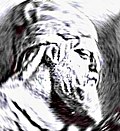
Scythia was a loose state that originated as early as the 8th century BC. Little is known of them and their rulers. Most detailed description came down to us from Herodotus.
- Scylas aka Skyles or Skylla (c. 500 BC – c. 450 BC) – Herodotus describes him as a Scythian whose mother was Greek, he was expelled by his people
- Octamasadas aka Oktamasades (c. 450 BC)
- Ateas the Thataean (c. 429 BC – 339 BC) – defeated by the Macedonians; his empire fell apart
- Skilurus aka Skylurus (c. 110 BC) – deposed c. 100 BC by the Sarmatians
- Palacus aka Palakus (c. 100 BC) – the last Scythian ruler, defeated by Mithridates VI of Pontus
Kings of Cimmerian Bosporus

The shores of Crimea were settled by Greeks since the 7th century BC. The kingdom was established around 480 BC. It was ruled by three consecutive dynasties: Archaenactidae (480 BC – 438 BC), Spartocids (438 BC – 108 BC), and Pontids (108 BC – 16 BC). After Pontids the territory became a Roman client kingdom.
Pontids
- Mithridates VI of Pontus (108 BC – 64 BC)
- Pharnaces (64 BC – 47 BC)
- Asander (47 BC – 17 BC)
- Scribonius (17 BC – 16 BC)
Migration period (c. 200 – c. 800)
In Eastern Europe the The Great Migration Period kicked off with the descent of the Goths from the Baltic region into the territory of modern Ukraine, about AD 200. They either took over or assimilated with the local Slavic tribes. The Goths were in turn pushed out by aggressively encroaching Huns, about 375. The Goths went on to conquer Southern Europe and the Huns moved to the Balkans and created a Hunnic Empire which lasted for a hundred years. After splitting of the Empire, some of the Huns moved back north in the territories of modern Ukraine and formed Patria Onoguria, now known as Old Great Bulgaria. In the 7th century Onoguria largely defected to Khazaria – an expanding Turkic state centered in the North Caucuses which controlled the Eurasian steppe until the 9th century.
Gothic rulers
In 238, the Goths for the first time passed the Danube, and took to the Black Sea. The division of the Goths (Thervingi-Vesi and Greuthungi-Ostrogothi) is first attested in 291.
Tervingi
The Balti dynasty, Balth(e)s, Baltungs, or Balthings, existed among the Tervingi ("forest people"), called later the Visigothi. The names of the Drevlyans and the Gothic Tervingi in Ukraine have often been adduced as parallels to agac-ari ("forest men" in Turkic).
- Nidad, reik ("ruler") (c. 218 – 249)
- Ovida, son of Nidad, co-ruler (c. 249 – 273)
- Cniva aka Kniwa ("knife"), brother of Ovida, co-ruler
- Ilderic aka Hilderith, son of Ovida, co-ruler (c. 273 – 317)
- Ariaric aka Ascaric, brother of Hilderith, co-ruler
- Geberic aka Geberich, son of Hilderith, kindin ("king") (c. 317 – 350)
- Athanaric aka Aþanareiks ("year-king"), pagan, Gunþi-reik ("battle prince") (365–381)
- Fritigern aka Frithugairns ("desiring peace"), converted to Arianism, Gunþi-reik (369–382)
Greuthungi
The Amali dynasty, Amals, Amaler, or Amalings of the Greuthungi ("steppe dwellers" or "people of the pebbly coasts"), called later the Ostrogothi.
- Amal (Amala), the Fortunate, born fl. 110 or c. 123
- Hisarna, (Isarna), the Iron One, born fl. 140 or c. 153
- Ostrogotha, the Patient, born fl. 170 or c. 183, died c. 250 in Ukraine
- Hunuil ("Immune to Magic") aka Ginvila, born fl. 210 or c. 213
- Athal (Athala), the Noble One, born fl. 240 or c. 243 in Ukraine
- Achiulf (Agiulf), born fl. 270 or c. 273 in Ukraine
- Wultwulf (Vultuulf, Vulthulf, Vuldulf), born fl. 300 in Ukraine, died fl. 370, prince of the Goths
- Ermanaric (Hermanaric, Ermanarich, Hermanarik), born c. 303 in Ukraine, king of the Getae/Greutungi/Ostrogoths (335 or 350 – 375 or 376)
- Winithar (Vinitharius), Conqueror of the Venedi-Slavs (Antes), born fl. 345 or c. 353 in Ukraine, the last independent king of the Ostrogoths (376–380)
- Hunimund ("Protege of the Huns"), the Beautiful, born c. 326 in Ukraine, the first Hunnic vassal prince of the Ostrogoths (376-fl.405)
Hunnic rulers
- Balambér aka Bülümer (Bulümar, Balamir), conqueror of the Ostrogoths (376–378)
- Baltazár aka Alyp-bi, king of the Western Huns (378–390), buried on Kuyantau (current Kiev)
- Uldin aka Ulduz, king of the Western Huns (390–c. 411)
- Donatus, King of the Eastern Huns (c. 382–412)
- Charaton aka Aksungur (Aksuvar), (c. 411–c. 422)
- Octar aka Oktar (Uptar ?), (c. 425–c. 430)
- Rugila aka Ruga (Rua, Roila), Yabgu (prince), then king (432–434)
- Mundzuk aka Aybat, Yabgu (390–434), King(434)
- Bleda, King and ruler of Eastern Huns (Ak Bulgar) (434–445)
- Attila the Hun, Yabgu of Western Huns (Kara Bulgar) (434–445)
- Ellac aka Ellak, Khagan and ruler of the Sabirs (453–454)
- Dengizich aka Tengiz (Diggiz), ruler of the Akatziroi, (454–468)
- Ernakh aka Bel-Kermek (Hernach), ruler of the Bulgars (455–465), and the Akatziroi (469–503)
Rulers of Patria Onoguria
According to Zakarius Rhetor and Priscus Rhetor, Patria Onoguria was a vulgar statelet in alliance with Byzantium established in 463 around Azov having been forced west upon the Akatziroi by the Sabirs who in turn were being attacked. Its 7th century period is commonly referred to as Old Great Bulgaria (~600–~690).
- Ernakh (469–503) raids on Byzantium
- Utigur (503–520)
- Grod (520–528) alliance with Byzantium
- Mugel and Chinialus (528–530) breaks alliance with Byzantium
- Sandilch (mid 6thC) in Southeast supported by Byzantium against Khinialon and Sinnion in Southwest, then Zabergan while Sarosius assists arrangement between Pseudo-Avars in North and Justinian I. Then Kagan Bayan controls the rest of Ukraine for most of the 60s until Sarosius assists Gokturks petition of Justin II to support a "true" Avar candidate in Patria Onoguria against the Pseudo-Avars.
- Houdbaad (c. 581–c. 600)
- Organa (617–630)
- Gostun (2 years)
- Kubrat (632–660) extended dominion of Great Bulgarian Onoguria into Pannonia placing Pseudo-Avars under Kuber in Sirmium.
- Batbayan ruled two years before being challenged and sent to Itil by his brother Kotrag who ensured Khazar rule over a loose confederation of tribal city-states from Kiev in the West to Bolghar in the Northeast and the Caspian Gates in the Southeast.
Khazar rulers
Khazar Khaganate controlled much of what is today southern and eastern Ukraine until the 10th century.
- Bulan Sabriel (fl. c. 740)
- Obadiah (c. 786–809)
- Hezekiah ben Obadiah
- Manasseh I ben Hezekiah
- Hanukkah ben Obadiah
- Isaac ben Hanukkah
- Zebulun ben Isaac
- Manasseh II ben Zebulun
- Nisi ben Manasseh
- Aaron I ben Nisi (fl. c. 900)
- Menahem ben Aaron (fl. c. 910)
- Benjamin ben Menahem (fl. c. 920)
- Aaron II ben Benjamin (c. 920s–940)
- Joseph ben Aaron (fl. 940–965)
Rulers of Kiev and Kievan Rus' (c. 375/800 – 1240/1362)
Legendary and historical rulers of Kiev
| Portrait | Name | Born-Died | Ruled From | Ruled Until |
|---|---|---|---|---|
| Bozh (Bož, Boz, Booz, Box), a king of Antes, the east Slavic people | 4th century | ? | 376 | |
| Alyp-bi (Baltazár), the son of Balambér aka Bülümer, a khan of the Western Huns who was buried on Kuyantau mountain (current Kiev) | 4th century | 378 | 390 | |
 |
Kyi, a legendary founder of Kiev, a Slavic prince of Kuyavia, most likely eastern Polans | 5th–6th centuries | 482 | ? |
| Oleg (Helge or Helgi), probably of Danish or Swedish origin, an apocryphal Kiev voivode, under the overlordship of the Khazar Khaganate | 8th century | ? | ? | |
| Bravlin, probably of Swedish origin,[3] a Varangian voivode in the Rus' Khaganate | 8th–9th centuries | c. 790 | c. 810 | |
 |
Askold and Dir (Høskuldr and Dýri),[4] probably of Swedish origin, Varangian konungs, not Rurikids, were rulers (khagans) of Kiev, not Kievan Rus' | ? - 882 | c. 842[5] | 882 |
The Rurikids were descendants of Rurik (Hrørekr), a Varangian pagan konung or chieftain, who supposedly was of haplogroup N1c1, which is common among Finno-Ugric peoples and not so rare in Baltic region.[6]
All the rulers of Kievan Rus' before the conversion of Vladimir I and all the country to Christianity are Pagan rulers, except Olga of Kiev.
| Portrait | Name | Born | Reign | Marriage (s) | Death | Notes |
|---|---|---|---|---|---|---|
| Rurik I (Рюрик) Old Norse: Rørik |

|
Unknown | 862-879 | Unknown at least one son |
879 | Ruled as Prince of Novgorod. Founder of the family. |
| Oleg the Seer (Олег Віщий) Old Norse: Helgi[7] |

|
Unknown | 879-912 | Unknown | 912 | Varangian kniaz of Holmgård (Novgorod) and Kønugård (Kiev). His relationship with the family is unknown. He was probably a regent, in name of Igor, son of Rurik. |
| Igor I the Old Igor Rurikovich (Ігор Старий[8]) Old Norse: Ingvar Röreksson |

|
c.878 Son of Rurik |
912-945 | Olga of Kiev 901 or 902 at least one son |
945 Iskorosten aged 66–67 |
|
| Saint Olga of Kiev (Saint Olga) (Свята Ольга) Old Norse: Helga |
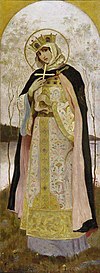
|
c.890 Pskov |
945-962 | Igor I the Old 901 or 902 at least one son |
11 July 969 Kiev aged 78–79 |
Regent on behalf of her minor son, she was baptized by Emperor Constantine VII but failed to bring Christianity to Kiev. |
| Sviatoslav I the Brave Sviatoslav Igorevich (Святосла́в Хоро́брий) Old Norse: Sveinald Ingvarsson[9] |

|
c.942 possibly Kiev Son of Igor I the Old and Saint Olga of Kiev |
962-972 | Predslava c.954 two sons Malusha/Malfrida[10][11] c.958 at least one son |
March 972 Khortytsia aged 29–30 |
The first true ruler of Rus' who destroyed the Khazar Khaganate and united all of the Rus' principalities under the Kiev throne. |
| Yaropolk I Yaropolk Sviatoslavich (Яропо́лк Святосла́вич) Old Norse: Iaropolk Sveinaldsson |

|
c.950 Son of Sviatoslav I the Brave and Predslava |
972-980 | A Greek nun at least one son |
980 Fort of Roden, near Kaniv aged 29–30 |
Supposedly was baptised into Catholicism, and then was murdered by two Varangians. |
| Vladimir I the Great Vladimir Basil Sviatoslavich (Володимир Великий/Володимѣръ Свѧтославичь) Old Norse: Valdamarr Sveinaldsson |

|
c.958 Budyatychi Son of Sviatoslav I the Brave and Malusha/Malfrida |
980-1015 | Olava/Allogia c.977 at least one son A Greek nun (widow of his brother) c.980 at least one son Rogneda of Polotsk c.978 (possibly in bigamy) eight children Adela (of Bulgaria?) at least two children (maximum four) Malfrida (of Bohemia?) Before 1000 two children Anna Porphyrogenita of Byzantium 988 Cherson three children Regelindis (?) of Saxony (granddaughter of Otto I, Holy Roman Emperor) After 1011 one or two daughters Unknown two children |
15 July 1015 Berestove, Kiev aged 57–58 |
His early rule is characterized by a staunch pagan reaction but in 988 he was baptized into Orthodoxy and successfully converted Kievan Rus' to Christianity. |
| Sviatopolk I the Accursed Sviatopolk Yaropolkovich (Святополк Окаянний) Old Norse: Sveinpolk Iaropolksson |

|
c.980 Son of Sviatoslav I the Brave and Predslava |
1015-1019 | Unknown name (daughter of Bolesław I of Poland) no children |
1019 aged 38–39 |
|
| Yaroslav I the Wise Yaroslav George Vladimirovich (Яросла́в Му́дрий) Old Norse: Jarizleifr Valdamarrsson[12] |

|
c.978 Son of Vladimir I the Great and Rogneda of Polotsk |
1019-1054 | Ingigerda of Sweden 1019 Novgorod eight or nine children |
20 February 1054 Vyshhorod aged 75–76 |
Prince of Rostov, Prince of Novgorod, and Grand Prince of Kiev; during his reign Kievan Rus' reached the pinnacle of its power. |
| Iziaslav I Iziaslav Demetrius Yaroslavich (Ізяслав Ярославич) Old Norse: Izjasleifr(?) Jarizleifsson |
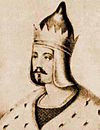
|
c.1024 Son of Yaroslav I the Wise and Ingigerda of Sweden |
1054-1068 1069-1073 1076-1078 |
Gertrude of Poland 1043 three children |
3 October 1078 Nizhyn aged 53–54 |
Reigned three times, threatened by the power of his relatives Vseslav of Polotsk (1068–69) and Sviatoslav II of Kiev (1073-76). First King of Rus', Pope Gregory VII sent him a crown from Rome in 1075. |
| Vseslav I the Seer Vseslav Basil Bryacheslavich (Всеслав Брячиславич) |

|
c.1039 Polotsk Son of Bryachislav of Polotsk |
1068-1069 | Unknown six sons |
24 April 1101 Polotsk aged 61–62 |
A brief ruler during Iziaslav's official reign. Also Prince of Polotsk. |
| Sviatoslav II Sviatoslav Nicholas Yaroslavich (Святослав Ярославич) Old Norse: Sveinald Jarizleifsson |
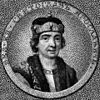
|
c.1027 Kiev Son of Yaroslav I the Wise and Ingigerda of Sweden |
1073-1076 | Cecilia of Dithmarschen [13] Between 1043 and 1047 five children Oda of Staden (Nordmark) c.1065 one son |
27 December 1076 Kiev aged 48–49 |
A brief ruler during his brother Iziaslav's official reign. |
| Vsevolod I Vsevolod Andrew Yaroslavich (Всеволод Ярославич) Old Norse: Vissivald Jarizleifsson |

|
c.1030 Son of Yaroslav I the Wise and Ingigerda of Sweden |
1078-1093 | Anastasia of Byzantium c.1053 two children Anna of Cumania c.1070 four children |
13 April 1093 Vyshhorod aged 62–63 |
Usurped the throne from his nephew, Yaropolk Iziaslavich. |
| Saint Yaropolk (III) Izyaslavich Yaropolk Peter Iziaslavich (Ярополк Ізяславич) Old Norse: Iaropolk Izjasleifsson (?) |
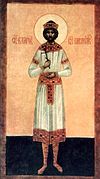
|
c.1043 Son of Iziaslav I and Gertrude of Poland |
1078-1087 | Kunigunde of Meissen c.1071 four children |
22 November 1087 Zvenyhorod aged 62–63 |
As hereditary King of Rus (title assumed until his death), was a legitimate contestant for the throne, usurped by his uncle. |
| Sviatopolk II Sviatopolk Michael Iziaslavich (Всеволод Ярославич) Old Norse: Sveinpolk Izjasleifsson (?) |
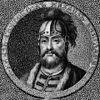
|
8 November 1050 Son of Iziaslav I and Gertrude of Poland |
1093-1113 | Unknown name (daughter of Spytihněv II of Bohemia)[14] c.1085 three children Olenna of the Kipchaks c.1094 four children |
26 April 1113 Vyshhorod aged 62 |
Recovered the throne of his father from his uncle. However, his descendants lost their rights to the Kievan throne. |
| Vladimir II Monomakh Vladimir Basil Vsevolodovich (Володимир Мономах) Old Norse: Valdamarr Vissivaldsson |

|
1053 Son of Vsevolod I and Anastasia of Byzantium |
1113-1125 | Gytha of Wessex c.1074 five or six children Euphemia of Byzantium c.1100 six or seven children Unknown name (daughter of Aepa Ocenevich, Khan in Cumania) After 1107 no known children |
19 May 1125 Kiev aged 71–72 |
He is considered to be the last ruler of the united Kievan Rus'. |
| Mstislav I the Great Mstislav Theodore Vladimirovich (Мстислав Великий) Old Norse: Haraldr Valdamarrsson |

|
1 June 1076 Turov Son of Vladimir II Monomakh and Gytha of Wessex |
1125-1132 | Christina of Sweden 1095 ten children Liubava Dmitrievna of Novgorod 1122 two children |
14 April 1132 Kiev aged 55 |
After his reign Kievan Rus' fell into recession starting a rapid decline. |
Decline of Kievan Rus'
After the Council of Liubech in 1097 Kievan Rus' entered a feudal period and was divided into principalities ruled by the Rurikid family princes who were in a constant power struggle with each other. Major principalities were: Galicia-Volhynia, Kiev, Chernigiv, and Pereyaslavl. In the period of 1240–1362, the three latter ones were forced to accept the Golden Horde overlordship.
Grand Prince of Kiev
| Portrait | Name | Born-Died | Ruled From | Ruled Until |
|---|---|---|---|---|
| Yaropolk II, brother of Mstislav I. | 1082–1139 | 1132 | 1139 | |
| Viacheslav I, brother of Yaropolk II and Mstislav II. First time. | 1083–1154 | 1139 | 1139 | |
 |
Vsevolod II, married Maria, sister of Mstislav I, Yaropolk II and Viacheslav I. | ?–1146 | 1139 | 1146 |
 |
Igor II, brother of Vsevolod II. | ?–1147 | 1146 | 1146 |
 |
Iziaslav II, son of Mstislav I and Christina Ingesdotter of Sweden. First time | 1097–1154 | 1146 | 1149 |
 |
Yuri I Dolgorukiy, first time | 1099–1157 | 1149 | 1151 |
| Viacheslav I, Second time, jointly with Iziaslav II | 1083–1154 | 1151 | 1154 | |
 |
Iziaslav II, second time, jointly with Viacheslav I. | 1097–1154 | 1151 | 1154 |
 |
Rostislav I, brother of Iziaslav II. First time | 1110–1167 | 1154 | 1154 |
 |
Iziaslav III, grandson of Sviatoslav II. First time. | ?–1162 | 1154 | 1155 |
 |
Yuri I Dolgorukiy, second time. | 1099–1157 | 1155 | 1157 |
 |
Iziaslav III, second time. | ?–1162 | 1157 | 1158 |
 |
Rostislav I, second time. Jointly with Iziaslav III in 1162. | 1110–1167 | 1158 | 1167 |
 |
Iziaslav III, third time, jointly with Rostislav I. | ?–1162 | 1162 | 1162 |
 |
Mstislav II, son of Iziaslav II and Agnes of Germany. First time. | ?–1172 | 1167 | 1169 |
| Gleb, son of Yuri Dolgorukiy. First time. | ?–1171 | 1169 | 1169 | |
 |
Mstislav II, second time. | ?–1172 | 1170 | 1170 |
| Gleb, second time. | ?-1171 | 1170 | 1171 | |
| Vladimir III, son of Mstislav I the Great and Liubava Dmitrievna. | 1132–1173 | 1171 | 1171 | |
| Michael I, half-brother of Gleb. | ?–1176 | 1171 | 1171 | |
| Roman I, son of Rostislav I and Agnes of Swabia. First time. | ?–1180 | 1171 | 1173 | |
 |
Vsevolod III the Big Nest, brother of Michael I. | 1154–1212 | 1173 | 1173 |
| Rurik Rostislavich, brother of Roman I. First time. | ?–1215 | 1173 | 1173 | |
| Sviatoslav III, son of Vsevolod II. First time. | ?–1194 | 1174 | 1174 | |
| Yaroslav II, son of Iziaslav II. First time. | ?–1180 | 1174 | 1175 | |
| Roman I, second time. | ?–1180 | 1175 | 1177 | |
| Sviatoslav III, second time. | ?–1194 | 1177 | 1180 | |
| Yaroslav II, second time. | ?–1180 | 1180 | 1180 | |
| Rurik Rostislavich, second time. | ?–1215 | 1180 | 1182 | |
| Sviatoslav III, third time. | ?–1194 | 1182 | 1194 | |
| Rurik Rostislavich, third time. | ?–1215 | 1194 | 1202 | |
| Igor III, son of Yaroslav II. First time. | ?–? | 1202 | 1202 | |
| Rurik Rostislavich, fourth time, jointly with Roman II and Rostislav II (until 1205). | ?–1215 | 1203 | 1205 | |
 |
Roman II the Great, son of Mstislav II. In his first time ruled jointly with Rurik and Rostislav II (until 1205). | 1160–1205 | 1203 | 1205 |
| Rostislav II, son of Rurik Rostislavich. Ruled jointly with his father 1204–1206 and with Roman II 1204–1205. | 1173–1214 | 1204 | 1206 | |
| Rurik Rostislavich, fifth time, jointly with his son Rostislav II. | ?–1215 | 1206 | 1206 | |
| Vsevolod IV the Red, son of Sviatoslav III. His baptismal name was "Daniil" (Daniel). First time. | ?–1212 | 1206 | 1207 | |
| Rurik Rostislavich, sixth and last time. | ?–1215 | 1207 | 1210 | |
| Vsevolod IV the Red, second time. | ?–1212 | 1210 | 1212 | |
| Igor III, second time. | ?–? | 1212 | 1214 | |
| Mstislav III, son of Roman I. | ?–1223 | 1214 | 1223 | |
| Vladimir IV, brother of Rostislav II. | 1187–1239 | 1223 | 1235 | |
| Iziaslav IV, a member of Rurik dynasty, descendant of Rurik . | 1186–? | 1235 | 1236 | |
 |
Yaroslav III, son of Vsevolod the Big Nest. First time | 1191–1246 | 1236 | 1238 |
 |
Michael II, son of Vsevolod IV. First time. | 1185–1246 | 1238 | 1239 |
| Rostislav III, son of Michael II. | 1210–1262 | 1239 | 1239 | |
| Daniel, son of Roman II the Great. | 1201–1264 | 1239 | 1240 | |
 |
Michael II, second time. | 1185–1246 | 1241 | 1246 |
 |
Yaroslav III, second time | 1191–1246 | 1246 | 1246 |
 |
St. Alexander Nevsky, son of Yaroslav III. | 1220–1263 | 1246 | 1263 |
 |
Yaroslav IV, brother of Alexander. | 1230–1271 | 1263 | 1271 |
 |
Lev, son of Daniel. | 1228–1301 | 1271 | 1301 |
| Volodymyr-Ivan Ivanovich | ?–? | 1301 | ? | |
| Stanislav Ivanovich | 1228–1301 | ? | 1321 |
- Since 1321 or 1324: Annexed by the Grand Duchy of Lithuania.
- Olgimont-Mykhailo (Algimantas Alšėniškis) (1324–1331)[15]
- Fiodor of Kiev (Teodoras Butvydaitis) (1331–1362)
Princes of Pereyaslavl
- Vsevolod I of Kiev, 1054–1076
- Rostislav Vsevolodich, died 1093
- Vladimir II Monomakh, 1076–1078 (first time)
- Rostislav Vsevolodich, 1078–1093
- Vladimir II Monomakh, 1094–1113 (second time)
- Sviatoslav Vladimirovich, died 1114
- Yaropolk II of Kiev, 1114–1132
- Vsevolod Mstislavich, 1132 (first time)
- Iziaslav Mstislavich, 1132 (first time)
- Vyacheslav Vladimirovich, 1132–1134 (first time)
- Vsevolod Mstislavich, 1134 (second time)
- Iziaslav Mstislavich, 1134 (second time)
- Andrey Vladimirovich, 1135–1141
- Vyacheslav Vladimirovich, 1142 (second time)
- Iziaslav II of Kiev, 1143–1145
- Mstislav Izyaslavich, 1146–1149 (first time)
- Rostislav Yurevich, 1149–1151
- Mstislav Izyaslavich, 1151–1155 (second time)
- Gleb of Kiev, 1155–1169
- Vladimir Glebovich, 1169–1187
- Yaroslav Mstislavich, ?–?
- Vsevolod the Big Nest, ?–1206
- Vsevolod Chermnyi Svyatoslavich, 1206
- Rurik Rostislavich, 1206
- Vladimir IV Rurikovich, 1206–1213
Princes of Chernihiv
- Sviatoslav II of Kiev, 1054–1073
- Vsevolod I of Kiev, 1073–1076 (first time)
- Vladimir Monomakh, 1076–1077
- Boris Vyacheslavich, 1077
- Vsevolod Yaroslavich, 1077–1078 (second time)
- Oleg I of Chernigov, 1078
- Vladimir Monomakh (second time), 1078–1094
- Oleg Sviatoslavich, 1094–1097
- David Sviatolavich, 1097–1123
- Yaroslav Sviatoslavich, 1123–1126
- Vsevolod II of Kiev, 1126–1139
- Vladimir Davidovich, 1139–1151
- Iziaslav Davidovich, 1151–1154
- Sviatoslav Olgovich, 1157–1164
- Oleg Sviatoslavich, 1164
- Sviatoslav Vsevolodich, 1164–1177
- Yaroslav II Vsevolodovich (1176–1198)[16][17]
- Igor Svyatoslavich the Brave (1198–1201/1202[18])[16]
- Oleg III Svyatoslavich (1201/1202[18]-1204)[16]
- Vsevolod III Svyatoslavich (1204–1206/1208)[16]
- Gleb I Svyatoslavich (1206/1208-1215/1220[19])[16]
- Mstislav II Svyatoslavich (1215/1220[19]-1223)[16]
- Mikhail I Vsevolodovich (1223–1235)[16] (first time)
- Mstislav III Glebovich (1235–1239/1241)[16]
- Rostislav I Mikhailovich (1241–1242)[16]
- Mikhail I Vsevolodovich (1242–1246)[16] (second time)
- Roman I Mikhailovich the Old (1246/1247–after 1288)[16][20][21]
- Oleg Romanovich, 13th century
- Mikhail, late 13th–early 14th century
- Mikhail Aleksandrovich, 14th century
- Roman Mikhailovich (the younger), died 1370
- Kaributas Algirdaitis (Dymitr Korybut, or Koribut), c. 1372–1393
- Roman Mikhailovich (the younger), restored, 1393–1401
- Švitrigaila, 1419–1430
Kings and Princes of Galicia-Volhynia (1199–1349)
Galicia-Volhynia was a Ruthenian (Ukrainian) state in Galicia and Volhynia. Depending on the title of the ruler it was called either principality or kingdom. The first king, Coloman of Galicia-Lodomeria, was crowned in 1215, although the first nominal king of Galicia was Andrew II of Hungary, the son of Béla III of Hungary, who reigned from 1188 to 1190.
| Portrait | Name | Born-Died | Ruled From | Ruled Until |
|---|---|---|---|---|
 |
Roman II the Great, Prince of Novgorod (1168–1170), Prince of Volhynia (1170–1188, 1189–1205), Prince of Halych (1188, 1199–1205), and Grand Prince of Kiev (1204–1205) | fl.1160–1205 | 1199 | 1205 |
 |
Coloman of Galicia-Lodomeria, Hungarian prince Kálmán, Prince of Halych (1214–15), became the first anointed and crowned and King of Galicia-Volhynia (rex Galiciae et Lodomeriae) in 1215 | 1208–1241 | 1214 | 1219 |
| Daniel I of Galicia, held many titles since early childhood culminating with the crowning by a papal legate, archbishop Opizo, in Dorohychyn in 1253, King of Rus', Grand Prince of Kiev | 1201–1264 | 1205 | 1264 | |
 |
Lev I, King of Rus', Prince of Belz (1245–1264), Prince of Peremyshl and Halych (1264–1269) who moved the capital of Galicia from Kholm to Lviv in 1272, Grand Prince of Kiev (1271–1301) | 1228–1301 | 1293 | 1301 |
 |
Yuri I, King of Rus', Prince of Belz (1264–1301) | fl.1252–1308 | 1301 | 1308 |
 |
Andrew II and Lev II, Kings of Rus', princes, joint rule, the last members of the Rurikid dynasty to rule Ukraine | ?–1323 | 1308 | 1323 |
 |
Yuri II-Boleslaw, natus dux et dominus Russiae, a member of the Piast dynasty (the first historical ruling dynasty of Poland) | 1308–1340 | 1325 | 1340 |
 |
Liubartas, prince, a member of the Gediminid dynasty, the last Ruthenian-Lithuanian ruler of Galicia-Volhynia, Prince of Volhynia (1323–1384) | c. 1300–1384 | 1340 | 1349 |
In 1349, Liubartas lost all territories, except for eastern Volhynia, to Casimir III of Poland. In 1366, a Polish-Lithuanian treaty was signed: eastern Volhynia with Lutsk retained under Liubartas' rule (the Grand Duchy of Lithuania), while Galicia, western Volhynia, and western Podolia were annexed by the Crown of the Kingdom of Poland.
In the Grand Duchy of Lithuania (1362–1569) and Kingdom of Poland (1569–1667/1793)
Princes of Kiev
In early 1320s, a Lithuanian army led by Gediminas defeated a Slavic army led by Stanislav of Kiev at the Battle on the Irpen' River, and conquered the city. The Tatars, who also claimed Kiev, retaliated in 1324–1325, so while Kiev was ruled by a Lithuanian prince, it had to pay a tribute to the Golden Horde. Finally, as a result of the Battle of Blue Waters in 1362, Kiev and surrounding areas were incorporated into the Grand Duchy of Lithuania by Algirdas, Grand Duke of Lithuania.
- Algimantas Alšėniškis (Olgimunt Holszański, Olgimont-Mykhailo Olshansky) (1324–1331)
- Fiodor of Kiev aka Teodoras Butvydaitis, brother of Gediminas (1331–1362)
- Vladimiras Algirdaitis (Volodymyr Olgerdovych) (1362–1394)
- Skirgaila (1395–1397)
- Ivan Olshansky (Jonas Alšėniškis) (1397–c. 1402)
- Jurgis Gedgaudas; lt (Jerzy Giedygołd) (1404–1411)
- Andriy Ivanovych Olshansky (c. 1412–c. 1422)
- Mykhailo Ivanovych Olshansky (1422–1432)
- Mykhailo Semenovych Boloban Olshansky (1433–1435)
- Švitrigaila (1435–c. 1440), Grand Duke of the Duchy of Rus (1432–c. 1440)
- Aleksandras Olelka (Olelko Volodymyrovych) (1443–1454)
- Simonas Olelkaitis (Semen Olelkovych) (1454–1471)

Voivodes of Kiev
When the Polish-Lithuanian Commonwealth was formed by the Union of Lublin in 1569, Kiev and surrounding areas, Podolia, Volhynia, and Podlaskie, as the Kiev Voivodeship, Bratslav Voivodeship, Volhynian Voivodeship, and Podlaskie Voivodeship, were transferred from Lithuania to Poland.
Crimean khans (1441–1783)
Crimean Tatars were not of the Ukrainian ethnos. Their Crimean Khanate ruled a large part of modern Ukraine, with a capital at Bakhchisaray.

| Date of Reign | Name | Notes |
|---|---|---|
| 1441–1466 | Hacı I Giray | |
| 1466–1467 | Nur Devlet | first reign |
| 1467 | Meñli I Giray | first reign |
| 1467–1469 | Nur Devlet | second reign |
| 1469–1475 | Meñli I Giray | second reign |
| 1475 | Hayder | |
| 1475–1476 | Nur Devlet | third reign |
| 1476–1478 | dynasty dismissed from power | |
| 1478–1515 | Meñli I Giray | third reign |
| 1515–1523 | Mehmed I Giray | |
| 1523–1524 | Ğazı I Giray | |
| 1524–1532 | Saadet I Giray | |
| 1532 | İslâm I Giray | |
| 1532–1551 | Sahib I Giray | |
| 1551–1577 | Devlet I Giray | |
| 1577–1584 | Mehmed II Giray | |
| 1584 | Saadet II Giray | |
| 1584–1588 | İslâm II Giray | |
| 1588–1596 | Ğazı II Giray | first reign |
| 1596 | Fetih I Giray | |
| 1596–1607 | Ğazı II Giray | second reign |
| 1607–1608 | Toqtamış Giray | |
| 1608–1610 | Selâmet I Giray | |
| 1610–1623 | Canibek Giray | first reign |
| 1623–1628 | Mehmed III Giray | † |
| 1628–1635 | Canibek Giray | second reign |
| 1635–1637 | İnayet Giray | |
| 1637–1641 | Bahadır I Giray | |
| 1641–1644 | Mehmed IV Giray | first reign |
| 1644–1654 | İslâm III Giray | |
| 1654–1666 | Mehmed IV Giray | second reign |
| 1666–1671 | Adil Giray | |
| 1671–1678 | Selim I Giray | first reign |
| 1678–1683 | Murad Giray | |
| 1683–1684 | Hacı II Giray | |
| 1684–1691 | Selim I Giray | second reign |
| 1691 | Saadet III Giray | |
| 1691–1692 | Safa Giray | |
| 1692–1699 | Selim I Giray | third reign |
| 1699–1702 | Devlet II Giray | first reign |
| 1702–1704 | Selim I Giray | fourth reign |
| 1704–1707 | Ğazı III Giray | |
| 1707–1708 | Qaplan I Giray | first reign |
| 1709–1713 | Devlet II Giray | second reign |
| 1713–1715 | Qaplan I Giray | second reign |
| 1716–1717 | Devlet III Giray | |
| 1717–1724 | Saadet IV Giray | |
| 1724–1730 | Meñli II Giray | first reign |
| 1730–1736 | Qaplan I Giray | third reign |
| 1736–1737 | Fetih II Giray | |
| 1737–1740 | Meñli II Giray | second reign |
| 1740–1743 | Selamet II Giray | |
| 1743–1748 | Selim II Giray | |
| 1748–1756 | Arslan Giray | first reign |
| 1756–1758 | Halim Giray | |
| 1758–1764 | Qırım Giray | first reign |
| 1765–1767 | Selim III Giray | first reign |
| 1767 | Arslan Giray | second reign |
| 1767–1768 | Maqsud Giray | |
| 1768–1769 | Qırım Giray | second reign |
| 1769–1770 | Devlet IV Giray | first reign |
| 1770 | Qaplan II Giray | |
| 1770–1771 | Selim III Giray | second reign |
| 1771–1775 | Sahib II Giray | † |
| 1775–1777 | Devlet IV Giray | second reign |
| 1777–1782 | Şahin Giray | first reign |
| 1782 | Bahadır II Giray | |
| 1782–1783 | Şahin Giray | second reign |
| † The reigns of Canibek Giray in 1624 and of Maqsud Giray in 1771–1772 are not listed. Though these khans were formally appointed by Ottoman sultans they did not reach the throne and did not rule Crimea. In the years mentioned, the authority in the Crimean Khanate was exercised by Mehmed III Giray and Sahib II Giray correspondingly. | ||
| Note: The nominal khans Şahbaz Giray (1787–1789) and Baht Giray (1789–1792) mentioned in some works are not listed in this table as they did not rule the Crimean Khanate annexed by Russian Empire in 1783. | ||
Hetmans of Ukrainian Cossacks (1506–1775)
A Hetman was a military and civil leader, democratically elected by the Cossacks.
Hetmans and commanders of Ukrainian Cossacks
Several Cossack regiments were operating in Ukraine at this time that were largely independent of each other, so some of the Hetmans' tenures overlap.
| 1486 - 1492 | Yuri Pats | governor of Kyiv; organizer Cossack units. | |
| 1488 - 1495 | Bogdan Glinski | Cossack leader, destroyer Ochakov. | |
| 1492 - 1505 | Dmitry Putyatych | Cossack leader. | |
| 1510 - 1524 | Senka Polozovych | governor of Kyiv; Cossack leader. | |
| 1514 - 1535 | Ostap Dashkevych | Cossack leader. | |
| 1516 - 1528 | Przecław Lanckoroński | Cossack leader. | |
| 1550 - 1557 | Dmytro Vyshnevetsky | founder of the fortress at Minor Khortytsia. | |
| 1568 | Birulya governmental | Cossack leader. | |
| 1568 | Carp Oil | Cossack leader. | |
| 1568 | Andrush | Moldavian boyar Cossack leader. | |
| 1568 | Lisun | Cossack leader. | |
| 1568 | Yatsko Belous | Cossack leader. | |
| 1568 | Andrew Lyakh | Cossack leader. | |
| 1577 - 1578 | Ioan Potcoavă | Cossack leader. | |
| 1578 | Lukyan Chornynskyy | Cossack leader, hetman. | |
| 1581 | Samuel Zborowski | Cossack leader, hetman. | |
| 1584 | Bogdan Mykoshynskyy | Cossack leader, hetman. | |
| 1585 | Michael Ruzhinskogo | Cossack leader, hetman. | |
| 1585 | Kirik Ruzhinskogo | Cossack leader, hetman. | |
| 1585 | Zachary Kulaga | Cossack leader, hetman. | |
| 1586 | Lukyan Chornynskyy | Cossack leader, hetman. | |
| 1586 | Bogdan Makoshynskyy | Cossack leader, hetman. | |
| 1588 | Potrebatskyy | Cossack leader, hetman. | |
| 1589 | Zachary Kulaga | Cossack leader, hetman. | |
| 1594 | Bogdan Mykoshynskyy | Cossack leader, hetman. | |
| 1594 - 1596 | Hryhoriy Loboda | Cossack leader. | |
| 1594 - 1596 | Severyn Nalyvaiko | Cossack leader. | |
| 1596 | Matthew Shaul | Cossack leader, hetman. | |
| 1596 | Krzysztof Krempskyy | Cossack leader, hetman. | |
| 1596 | Krzysztof Nechkovskyy | Cossack leader, hetman. | |
| 1596 - 1597 | Gnat Vasiljevic | Cossack leader, hetman. | |
| 1597 | Tykhin Baybuza | Cossack leader, hetman. | |
| 1598 | Florian Giedroyc | Cossack leader. | |
| 1598 | Mitlovskyy | Cossack leader. | |
| 1602 - 1603 | John Kutskovych | Cossack leader, hetman. | |
| 1603 | John Oblique | Cossack leader, hetman. | |
| 1606 | Gregory Izapovych | Cossack leader, hetman. | |
| 1606 | Samuel Zborowski | Cossack leader, hetman. | |
| 1606 | Olevchenko Bogdan | Cossack leader, hetman. | |
| 1617 | Dmitry Barabash | Cossack leader, hetman. | |
| 1618 | Michael Skiba | Cossack leader. | |
| 1619 - 1621 | Yatsko Nerodych | Cossack leader, hetman. | |
| 1620 | Peter Odynets | Cossack leader. | |
| 1624 | Hryhoriy Chorny | Cossack leader, hetman. | |
| 1625 | Theodore Pyrskyy | Cossack leader, hetman. | |
| 1628 | Hryhoriy Chorny | Cossack leader, hetman. | |
| 1629 - 1630 | Hryhoriy Chorny | Cossack leader, hetman. | |
| 1630 | Taras Fedorovych | Cossack leader, hetman. | |
| 1632 | Simon Tying | Cossack leader, hetman. | |
| 1632 | Andrey Didenko | Cossack leader, hetman. | |
| 1633 | Dorofiy Doroshenko | Cossack leader, acting hetman. | |
| 1633 | kettlebell Kanevets | Cossack leader. | |
| 1633 - 1635 | Ivan Sulyma | Cossack leader, hetman. | |
| 1636 - 1637 | Basil Tomylenko | Cossack leader, hetman. | |
| 1637 | Pavel Mikhnovych | Cossack leader, hetman. | |
| 1638 | James Ostrainyn | Cossack leader, hetman. | |
| 1638 | Dmytro Hunia | Cossack leader, hetman. | |
| 1639 - 1642 | Carp half-housings | Cossack leader, hetman. | |
| 1642 - 1646 | Maxim Gulak | Cossack leader, hetman. |
Hetmans of the Cossack state
Following the Khmelnytsky uprising a new Cossack republic, the Hetmanate, was formed.
| # | Hetman | Elected (event) | Took office | Left office | |||
|---|---|---|---|---|---|---|---|
| style="background:Template:Independent (politician)/meta/color"| 1 | 
|

|
Bohdan Khmelnytsky (1596–1657) Зиновій-Богдан Хмельницький |
1648 (Sich) | 26 January 1648 | 6 August 1657 | died |
| style="background:Template:Independent (politician)/meta/color"| 2 | 
|

|
Yurii Khmelnytsky (1641–1685) Юрій Хмельницький |
death of his father | 6 August 1657 | 27 August 1657 | reconsidered by the Council of Officers |
| style="background:Template:Independent (politician)/meta/color"| 3 | 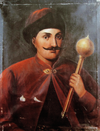
|

|
Ivan Vyhovsky (????–1664) Іван Виговський |
1657 (Korsun) | 27 August 1657 (confirmed: 21 October 1657) |
11 September 1659 | surrendered title |
| style="background:Template:Independent (politician)/meta/color"| 4 | 
|

|
Yurii Khmelnytsky (1641–1685) Юрій Хмельницький |
1659 (Hermanivka) | 11 September 1659 (confirmed: 11 September 1659) |
October 1662 | surrendered title |
Hetmans during the Ruin
The Ruin (1660–1687) was a time in Ukrainian history when the country fell into disarray and chaos. Afterwards, the Cossack state emerged as a vassal of the Russian Empire. During this period a number of hetmans stayed in power for short periods of time and often controlled only parts of the country. Moreover, the Treaty of Andrusovo (1667) split the Cossack Hetmanate along the Dnieper River into Left-bank Ukraine, which enjoyed a degree of autonomy within the Tsardom of Russia; and Right-bank Ukraine which remained part of the Polish-Lithuanian Commonwealth, at times (1672–1699) occupied by the Ottoman Empire.
| Right-bank Ukraine | Left-bank Ukraine | ||||||
|---|---|---|---|---|---|---|---|
| 1660—1663 | Yurii Khmelnytsky | 1660—1663 | Yakym Somko | ||||
| 1663—1665 | Pavlo Teteria | 1663—1668 | Ivan Briukhovetsky | ||||
| 1665—1668 | Petro Doroshenko | ||||||
| Unification | |||||||
| 1668—1669 | Petro Doroshenko | ||||||
| Partition | |||||||||||
|---|---|---|---|---|---|---|---|---|---|---|---|
| Right-bank Ukraine | Left-bank Ukraine | ||||||||||
| 1669—1676 | Petro Doroshenko | 1669—1674 | Mykhailo Khanenko | 1669—1672 | Demian Mnohohrishny | ||||||
| 1678—1681 | Yurii Khmelnytsky | 1675—1679 | Ostap Gogol | 1672—1687 | Ivan Samoilovych | ||||||
| 1681—1684 | Gheorghe Duca | 1683—1684 | Stefan Kunicki | ||||||||
| 1685 | Yurii Khmelnytsky | 1684—1689 | Andrii Mohyła | ||||||||
| 1687—1708 | Ivan Mazepa | ||||||||||
| Unification | |||||||||||
| 1708—1722 | Ivan Skoropadsky | 1708—1709 | Ivan Mazepa | ||||||||
| 1708—1718 | Pylyp Orlyk | ||||||||||
| 1718—1742 | Pylyp Orlyk | 1722—1724 | Pavlo Polubotok | ||||||||
| 1727—1734 | Danylo Apostol | ||||||||||
| 1750—1764 | Kirill Razumovsky | ||||||||||
In the Russian Empire (1667/1793–1917) and Austria-Hungary (1526/1772–1918)
After the dissolution of the Cossack Hetmanate, a new Malorossiyan collegium was established in 1764, and the Zaporozhian Host was disbanded in 1775. As a result of the second and third Partitions of Poland in 1793 and 1795, eastern and central parts of Ukraine were incorporated directly into the Russian Empire. Western Ukraine was annexed into the Habsburg Monarchy earlier, in the following order: Carpathian Ruthenia (1526), Galicia (1772), and Bukovina (1775).
The Russian Empire existed until 1917, and the Dual Monarchy, Austria–Hungary, existed until 1918.
Ukrainian People's Republic (1917–1921)
The Ukrainian People's Republic (UNR, 1917–1921) was formed after the Russian Revolution of 1917, and lasted until the Peace of Riga between Poland and Soviet Russia in March 1921. The leadership title varied and, despite a rather widespread misconception, none of them had the official title of president.
Chairmen of the Central Council
The Central Council (Tsentral’na rada) was the representative body governing the UNR.
Ukrainian Socialist-Revolutionary Party
| № | Portrait | Name | In Office From | In Office Until | Party | |
|---|---|---|---|---|---|---|
| 1 | 
|
Mykhailo Hrushevskyi 1866–1934 |
27 March 1917 | 29 April 1918 | Ukrainian Socialist-Revolutionary Party | |
- Volodymyr Naumenko and Serhiy Yefremov (27–29 April 1917 (acting for Hrushevsky)
Hetman of the Ukrainian State
A very short lived Hetmanate was established by Pavlo Skoropadskyi in 1918.
| # | Hetman | Elected (event) | Took office | Left office | |||
|---|---|---|---|---|---|---|---|
| style="background:Template:Independent (politician)/meta/color"| 1 | 
|

|
Pavlo Skoropadskyi 1873–1945 |
Russian Revolution of 1917 | 29 April 1918 | 14 December 1918 | Removed from power in an uprising led by the social democrat Symon Petliura |
Chairmen of the Directory
The Directorate of Ukraine was a provisional council of the UNR formed after Skoropadskyi's Hetmanate fell apart. On 22 January 1919, the Act of Unification of the Ukrainian People's Republic and the West Ukrainian People's Republic was passed. The text of the universal was made by the members of the Directory.
Ukrainian Social Democratic Labour Party
| № | Portrait | Name | In Office From | In Office Until | Party | |
|---|---|---|---|---|---|---|
| 1 | 
|
Volodymyr Vynnychenko 1880–1951 |
14 December 1918 | 11 February 1919 | Ukrainian Social Democratic Labour Party | |
| 2 | File:Симон Петлюра.jpg | Symon Petliura 1879–1926 |
11 February 1919 | 7 May 1921 | Ukrainian Social Democratic Labour Party | |
West Ukrainian People's Republic (1918–1919)
The government of the West Ukrainian People's Republic (WUNR) was proclaimed on 19 October 1918. WUNR was united with the Ukrainian People's Republic on 22 January 1919, although it was mostly a symbolic act while the western Ukrainians retained their own Ukrainian Galician Army and government structure. After the Polish-Ukrainian War (1918–1919), Poland took over most of territory of the West Ukrainian People's Republic by July 1919. Since November 1919, the government of the WUNR was in exile.
President of the Ukrainian National Republic
Ukrainian People's Labor Party
| № | Portrait | Name | In Office From | In Office Until | Party | |
|---|---|---|---|---|---|---|
| 1 | 
|
Yevhen Petrushevych 1863–1940 |
19 October 1918 | 15 March 1923 | Ukrainian People's Labor Party | |
President of the Carpatho-Ukraine
Christian People's Party
| № | Portrait | Name | In Office From | In Office Until | Party | |
|---|---|---|---|---|---|---|
| 1 | 
|
Avgustyn Voloshyn 1874–1945 |
15 March 1939 | 16 March 1939 | Christian People's Party | |
Ukrainian State (1941)
Prime Minister of the Ukrainian State
Organization of Ukrainian Nationalists
| № | Portrait | Name | In Office From | In Office Until | Party | |
|---|---|---|---|---|---|---|
| 1 | 
|
Yaroslav Stetsko 1912–1986 |
30 June 1941 | 9 July 1941 | Organization of Ukrainian Nationalists | |
Ukrainian Soviet Socialist Republic (1918/1919–1991)
Ukraine was incorporated into the Union of Soviet Socialist Republics on 30 December 1922.
Secretaries of the Central Committee of the Communist Party (Bolsheviks) of Ukraine

- Mykola Oleksiiovych Skrypnyk (20 April – 26 May 1918) (Secretary of the Organizational Bureau)
- Yurii Leonidovych Pyatakov (12 July – 9 September 1918)
- Serafima Ilyinichna Hopner (9 September – 23 October 1918)
- Emmanuil Ionovich Kviring (23 October 1918 – 30 May 1919)
- Stanislav Vikentevich Kosior (30 May – 10 December 1919) (1st time)
- Vacant (10 December 1919 – January 1920)
- Rafail Borisovich Farbman ( – 23 January March 1920) (acting)
- Nikolay Ilyich Nikolayev (23–25 March 1920)
- Stanislav Vikentevich Kosior (25 March – 23 November 1920) (2nd time)
First Secretary of the Central Committee
- Vyacheslav Mihailovich Molotov (23 November 1920 – 22 March 1921)
Executive Secretary of the Central Committee
- Feliks Yakovlevich Kon (22 March – 15 December 1921)
First Secretaries of the Communist Party
- Dmitry Zakharovich Manuilsky (15 December 1921 – 10 April 1923)
- Emmanuil Ionovich Kviring (10 December 1923 – 20 March 1925)
General Secretaries of the Central Committee
- Emmanuil Ionovich Kviring (20 March – 7 April 1925)
- Lazar Moiseyevich Kaganovich (7 April 1925 – 14 July 1928)
- Stanislav Vikentevich Kosior (14 July 1928 – 23 January 1934)
First Secretaries of the Central Committee

- Stanislav Vikentevich Kosior (23 January 1934 – 27 January 1938)
- Nikita Sergeyevich Khrushchev (27 January 1938 – 3 March 1947) (1st time, acting) (in Russian SFSR exile from 1941 until 1944)
- Lazar Moiseyevich Kaganovich (3 March – 26 December 1947) (2nd time)
- Nikita Sergeyevich Khrushchev (26 December 1947 – 16 December 1949) (2nd time)
- Leonid Georgyevich Melnikov (16 December 1949 – 4 June 1953)
- Aleksey Illarionovich Kirichenko (4 June 1953 – 26 December 1957)
- Nikolay Viktorovich Podgorny (26 December 1957 – 2 July 1963)
- Pyotr Yefimovich Shelest (2 July 1963 – 25 May 1972)
- Vladimir Vasilyevich Shcherbitsky (25 May 1972 – 28 September 1989)
- Vladimir Antonovich Ivashko (28 September 1989 – 22 June 1990)
- Stanislav Ivanovich Gurenko (22 June 1990 – 1 September 1991)
Ukraine (1991 – present)
On 5 July 1991, the Verkhovna Rada of the Ukrainian SSR passed a law establishing the post of the President of the Ukrainian SSR. The title was changed to the President of Ukraine upon the proclamation of independence (24 August 1991). The first election of the President of Ukraine was held on 1 December 1991.
Presidents
Our Ukraine Party of Regions Batkivshchyna Petro Poroshenko Bloc / UDAR Independent / Non-partisan
| № | Portrait | Presidents | Term of office | Presidential mandate | Affiliation | ||
|---|---|---|---|---|---|---|---|
| 1 | style="background:Template:Independent (politician)/meta/color"| | 
|
Leonid Kravchuk (b. 1934) Леонід Кравчук |
5 December 1991 Inauguration: 22 August 1992[a] |
19 July 1994 | 1991 — 61.59% 19,643,481 |
Independent / Non-partisan |
| 2 | rowspan=2 style="background:Template:Independent (politician)/meta/color" | | 
|
Leonid Kuchma (b. 1938) Леонід Кучма |
19 July 1994 | 14 November 1999 | 1994 — 52.3% 14,016,850 |
Independent / Non-partisan |
| 14 November 1999 | 23 January 2005 | 1999 — 57.7% 15,870,722 | |||||
| 3 | style="background:Template:Our Ukraine/meta/color;"| | 
|
Viktor Yushchenko (b. 1954) Віктор Ющенко |
23 January 2005 | 25 February 2010 | 2004 — 51.99% 15,115,712 |
Non-partisan (2004–2005) Our Ukraine (2005–nowadays) |
| 4 | style="background:Template:Party of Regions/meta/color; color:white"| | 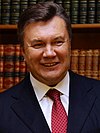
|
Viktor Yanukovych (b. 1950) Віктор Янукович |
25 February 2010 | 22 February 2014[b] | 2010 — 48.95% 12,481,266 |
Non-partisan[22] (Supported by Party of Regions) |
| — | style="background:Template:Batkivshchyna/meta/color; color:white"| | 
|
Oleksandr Turchynov (b. 1964) Олександр Турчинов (acting) |
22 February 2014 | 7 June 2014 | ex officio (as Chairman of Parliament, Article 112) |
Batkivshchyna |
| 5 | 
|
Petro Poroshenko (b. 1965) Петро Порошенко |
7 June 2014 | Incumbent | 2014 — 54.70% 9,857,308 |
Non-partisan (Supported by Petro Poroshenko Bloc & UDAR) | |
See also
- Scythia
- Kings of Cimmerian Bosporus
- Kingdom of Pontus
- Goths
- Huns, List of Hunnic rulers
- Bulgars
- Khazars, List of Khazar rulers,
- List of Crimean khans
- List of rulers of Galicia and Volhynia
- List of Galician rulers
- List of leaders of Ukraine
- President of Ukraine
- Prime Minister of Ukraine
References
- ^ Definition of UKRAINIAN, Merriam-Webster
- ^ uk:Скіфські царі
- ^ Staraya Ladoga (Aldeigjuborg)
- ^ Nordiska furstar lade grunden till Ryssland
- ^ Suszko, Henryk (2003). Latopis hustyński. Opracowanie, przekład i komentarze. Slavica Wratislaviensia CXXIV. Wydawnictwo Uniwersytetu Wrocławskiego. ISBN 83-229-2412-7; Tolochko, Oleksiy (2010). The Hustyn' Chronicle. (Harvard Library of Early Ukrainian Literature: Texts). ISBN 978-1-932650-03-7
- ^ DNA Testing of the Rurikid and Gediminid Princes
- ^ Sveerne
- ^ Історія України: Посібник - Олександр Палій - Google книги
- ^ Leszek Moczulski, Narodziny Międzymorza, p.475, Bellona SA, Warszawa 2007 ISBN 978-83-11-10826-4
- ^ Vladimir Plougin: Russian Intelligence Services: The Early Years, 9th-11th Centuries, Algora Publ., 2000
- ^ History of Ukraine-Rus': From prehistory to the eleventh century, Canadian Institute of Ukrainian Studies Press, 1997
- ^ Also known as Jarisleif I. See Google books
- ^ [1]
- ^ According to A. Nazarenko. It was thought not long ago that the first wife of Sviatopolk was Barbara Komnene, a supposed daughter of Alexios I Komnenos. However, the lack of tradition of such a name in the Byzantine Empire led to doubt. Today she may be considered fictional.
- ^ http://izbornyk.org.ua/dynasty/dyn40.htm
- ^ a b c d e f g h i j k Dimnik, Martin. The Dynasty of Chernigov – 1146–1246.
- ^ Other source suggests that Yaroslav II Vsevolodovich ruled from 1181 ([2]. Retrieved 13 April 2009), but his brother Sviatoslav Vsevolodovich became grand prince of Kiev in 1176 and promoted him to Chernigov; Dimnik, Martin op. cit. p 137.
- ^ a b A number of historians claim Igor Svyatoslavich died in 1202 ([3]. Retrieved 13 April 2009); he most probably died in the spring of 1201, because most chronicles place the news of his death as the first entry for the year; Dimnik, Martin op. cit p. 237.
- ^ a b Some historians claim Gleb Svyatoslavich died in 1219 ([4]. Retrieved 13 April 2009); he was last mentioned under 1215 and he died between 1215 and 1220; Dimnik, Martin op. cit p. 291.
- ^ Under the year 1261, the chronicles report that prince Vasilko Romanovich of Volodymyr-Volynskyi gave away his daughter Olga as wife to Andrey Vsevolodovich of Chernigov. Based on this report, some historians claim that Andrey Vsevolodovich was the prince of Chernigov between 1245 and 1261 ([5]. Retrieved 13 April 2009). However, the chronicler's identification of Andrey as a prince of Chernigov merely signified that he was an Olgovich (a member of the dynasty of Chernigov); Dimnik, Martin op. cit p. 380.
- ^ The Lyubetskiy sinodik speaks of a certain "Lavrenty Vsevolod Yaropolchi"; R. V. Zotov suggests that Vsevolod succeeded Mikhail Vsevolodovich to Chernigov from 1246 to 1263(see also: [6]. Retrieved 13 April 2009); the chronicles, however, do not support Zotov's assertions; Dimnik, Martin op. cit p. 380.
- ^ Янукович припинив членство у Партії регіонів : Новини УНIАН
